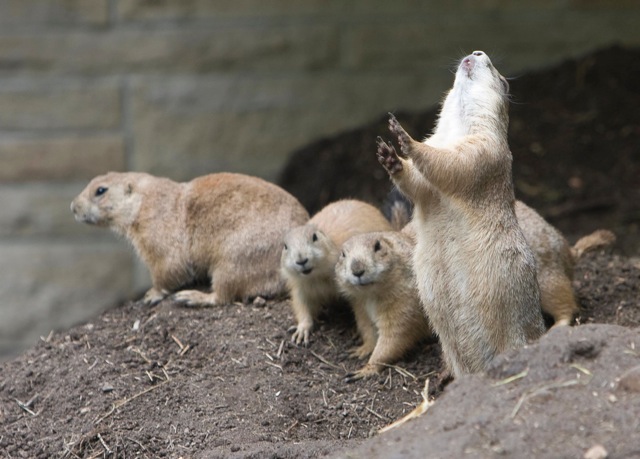
A jump yip display // Photo: Darlene Stack
Prairie dogs do ‘the wave’
After decades of speculation, University of Manitoba biologists learn why prairie dogs do “the wave”
Black-tailed prairie dogs use jump-yip displays, which resemble “the wave” at sports events, to gauge how reliable their neighbours are, University of Manitoba biologists report.
In a jump-yip display the animal jolts upright, jerks its head back and forelimbs up, and emits a “wee-oo” sound. As Professor James Hare from the department of biological sciences and his colleagues note in their paper published in the journal Proceedings of the Royal Society B, this work reveals that black-tailed prairie dogs use these displays to probe the responsiveness of their neighbours, effectively testing their level of vigilance, and adjusting their behaviour according to how much they can rely on their neighbours’ awareness of potential predators in their environment. The paper’s title: “Catch the wave: prairie dogs assess neighbours’ awareness using contagious displays”.
Previously, this display has commonly been regarded as an “all clear” signal, but its production with predators present suggests that’s not the case.
The philosophical rodent
“This fits beautifully with work on primates, including humans, which suggests that contagious displays – like yawning – provide a window into the mind of others, suggesting of course, that species probing the minds of others are aware that they are distinct from those individuals. That is to say, they are consciously aware,” Hare says.
“Prairie dogs foraged less when individuals were less responsive to their jump-yip display, suggesting they use jump-yips to actively probe the awareness of their neighbours.”
Beyond these broad implications, Hare and his team’s findings provide resolution to decades of speculation as to what function these unique multi-modal (visual and auditory) displays serve among prairie dogs. The findings also suggest yet another way that sociality — particularly the use of public information — allows animals to forage optimally in the face of high predation risk, taking into account not only the number of individuals above ground within their social group, but their current state of awareness.
Professor Hare’s research on this project was funded by the Natural Sciences and Engineering Research Council of Canada in the form of Discovery Grant Funding, and in the form of a Post-Graduate Scholarship to Robert Senkiw, whose Master’s thesis research forms the basis of the published work.
Further Reading
This story was covered by other media, such as The National Geographic.
Error thrown
Object of class WP_Error could not be converted to string






